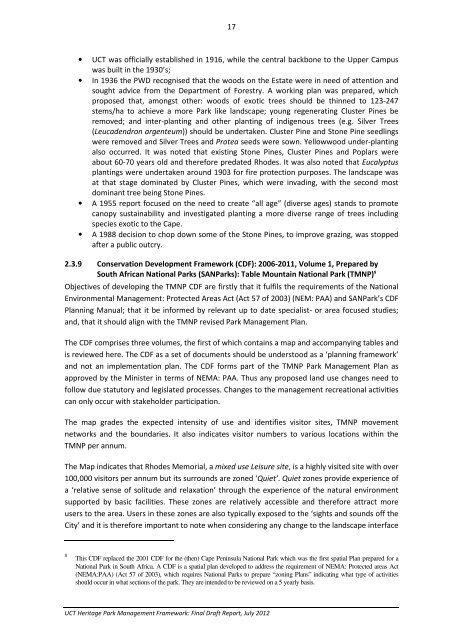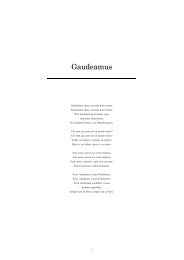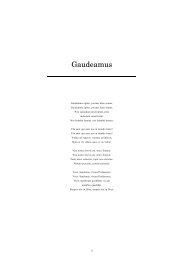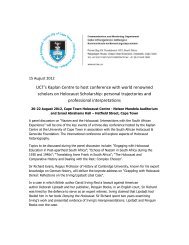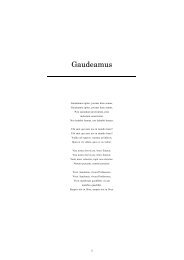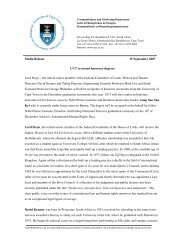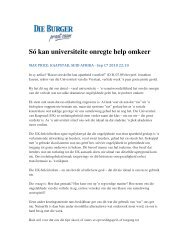uct heritage park management framework - University of Cape Town
uct heritage park management framework - University of Cape Town
uct heritage park management framework - University of Cape Town
Create successful ePaper yourself
Turn your PDF publications into a flip-book with our unique Google optimized e-Paper software.
17<br />
• UCT was <strong>of</strong>ficially established in 1916, while the central backbone to the Upper Campus<br />
was built in the 1930’s;<br />
• In 1936 the PWD recognised that the woods on the Estate were in need <strong>of</strong> attention and<br />
sought advice from the Department <strong>of</strong> Forestry. A working plan was prepared, which<br />
proposed that, amongst other: woods <strong>of</strong> exotic trees should be thinned to 123-247<br />
stems/ha to achieve a more Park like landscape; young regenerating Cluster Pines be<br />
removed; and inter-planting and other planting <strong>of</strong> indigenous trees (e.g. Silver Trees<br />
(Leucadendron argenteum)) should be undertaken. Cluster Pine and Stone Pine seedlings<br />
were removed and Silver Trees and Protea seeds were sown. Yellowwood under-planting<br />
also occurred. It was noted that existing Stone Pines, Cluster Pines and Poplars were<br />
about 60-70 years old and therefore predated Rhodes. It was also noted that Eucalyptus<br />
plantings were undertaken around 1903 for fire protection purposes. The landscape was<br />
at that stage dominated by Cluster Pines, which were invading, with the second most<br />
dominant tree being Stone Pines.<br />
• A 1955 report focused on the need to create “all age” (diverse ages) stands to promote<br />
canopy sustainability and investigated planting a more diverse range <strong>of</strong> trees including<br />
species exotic to the <strong>Cape</strong>.<br />
• A 1988 decision to chop down some <strong>of</strong> the Stone Pines, to improve grazing, was stopped<br />
after a public outcry.<br />
2.3.9 Conservation Development Framework (CDF): 2006-2011, Volume 1, Prepared by<br />
South African National Parks (SANParks): Table Mountain National Park (TMNP) 8<br />
Objectives <strong>of</strong> developing the TMNP CDF are firstly that it fulfils the requirements <strong>of</strong> the National<br />
Environmental Management: Protected Areas Act (Act 57 <strong>of</strong> 2003) (NEM: PAA) and SANPark’s CDF<br />
Planning Manual; that it be informed by relevant up to date specialist- or area focused studies;<br />
and, that it should align with the TMNP revised Park Management Plan.<br />
The CDF comprises three volumes, the first <strong>of</strong> which contains a map and accompanying tables and<br />
is reviewed here. The CDF as a set <strong>of</strong> documents should be understood as a ‘planning <strong>framework</strong>’<br />
and not an implementation plan. The CDF forms part <strong>of</strong> the TMNP Park Management Plan as<br />
approved by the Minister in terms <strong>of</strong> NEMA: PAA. Thus any proposed land use changes need to<br />
follow due statutory and legislated processes. Changes to the <strong>management</strong> recreational activities<br />
can only occur with stakeholder participation.<br />
The map grades the expected intensity <strong>of</strong> use and identifies visitor sites, TMNP movement<br />
networks and the boundaries. It also indicates visitor numbers to various locations within the<br />
TMNP per annum.<br />
The Map indicates that Rhodes Memorial, a mixed use Leisure site, is a highly visited site with over<br />
100,000 visitors per annum but its surrounds are zoned ‘Quiet’. Quiet zones provide experience <strong>of</strong><br />
a ‘relative sense <strong>of</strong> solitude and relaxation’ through the experience <strong>of</strong> the natural environment<br />
supported by basic facilities. These zones are relatively accessible and therefore attract more<br />
users to the area. Users in these zones are also typically exposed to the ‘sights and sounds <strong>of</strong>f the<br />
City’ and it is therefore important to note when considering any change to the landscape interface<br />
8 This CDF replaced the 2001 CDF for the (then) <strong>Cape</strong> Peninsula National Park which was the first spatial Plan prepared for a<br />
National Park in South Africa. A CDF is a spatial plan developed to address the requirement <strong>of</strong> NEMA: Protected areas Act<br />
(NEMA:PAA) (Act 57 <strong>of</strong> 2003), which requires National Parks to prepare “zoning Plans” indicating what type <strong>of</strong> activities<br />
should occur in what sections <strong>of</strong> the <strong>park</strong>. They are intended to be reviewed on a 5 yearly basis.<br />
UCT Heritage Park Management Framework: Final Draft Report, July 2012


